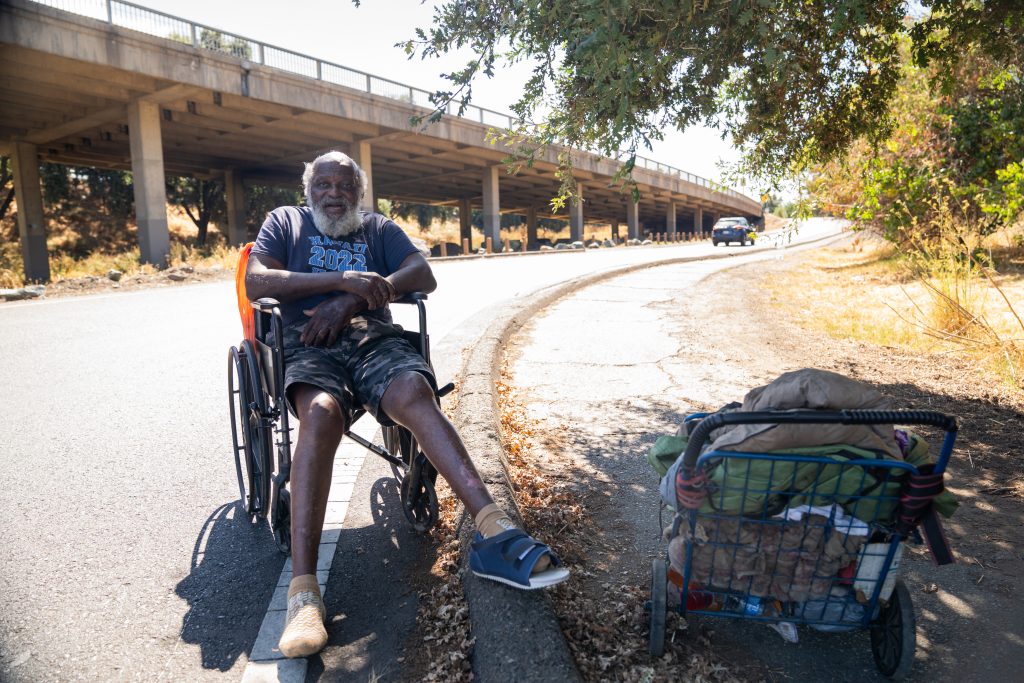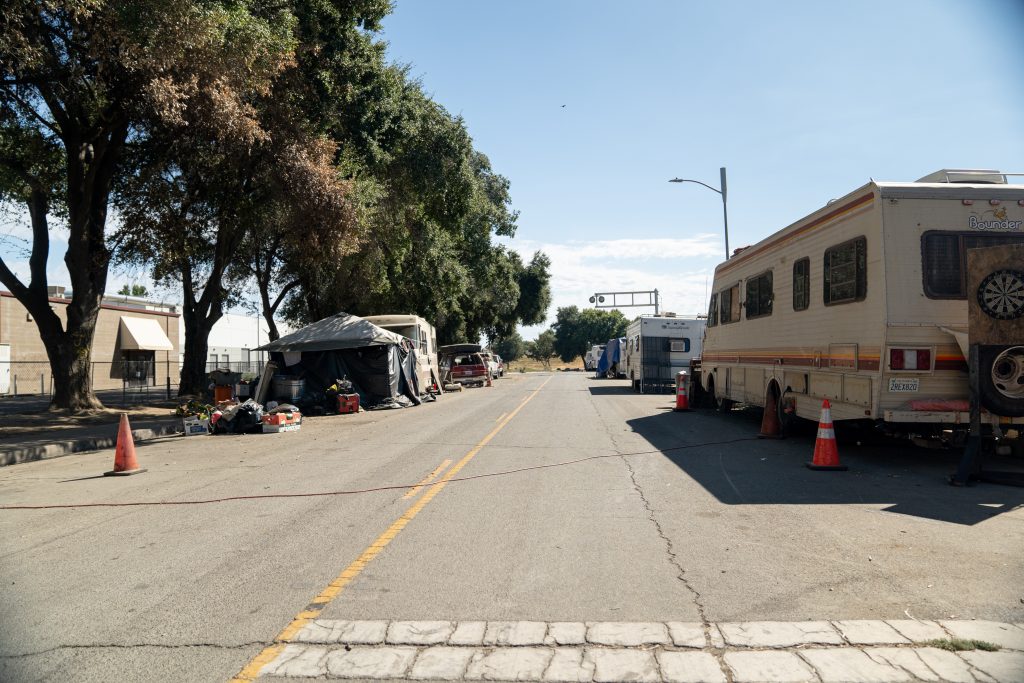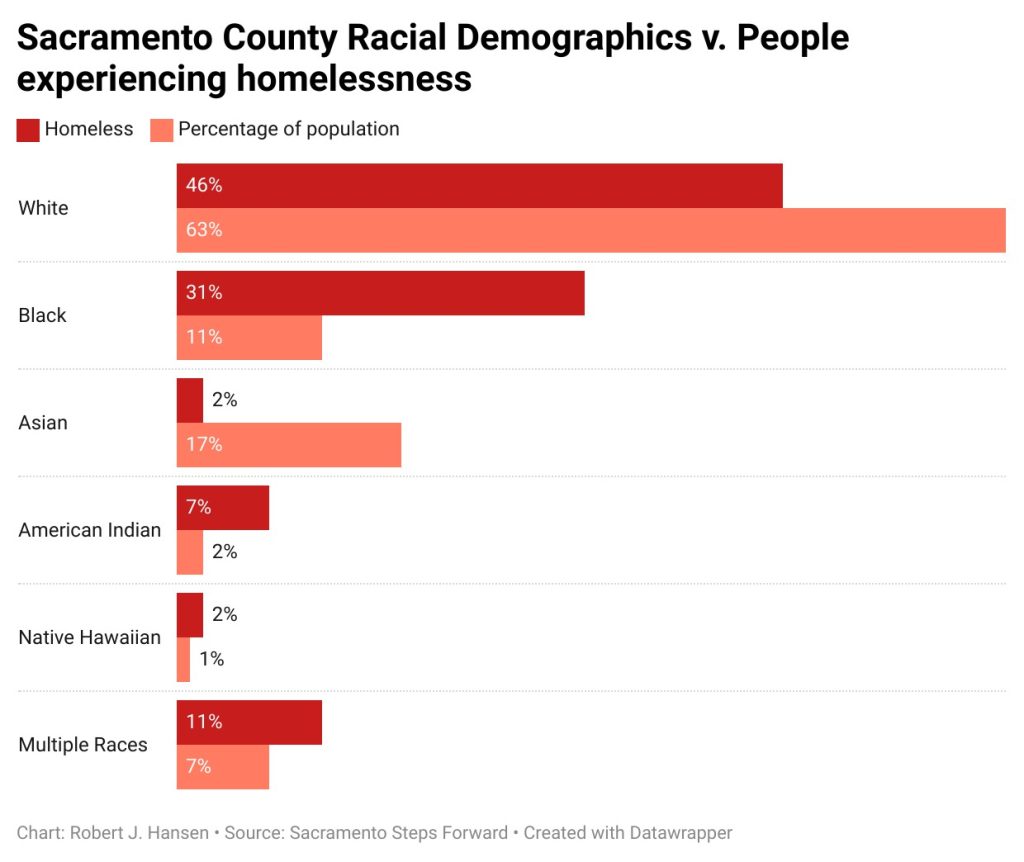Sacramento’s homeless, among whom Blacks are disproportionately counted, face daunting barriers to escaping life on the streets
By Robert J. Hansen
Underneath and alongside the American River Bike Trail sit several scattered tents and makeshift shelters that the people living outdoors in Sacramento call home.
Some have lived outdoors a few years, some for more than a decade. All make up the nearly 10,000 homeless individuals who live in Sacramento County, more than two thirds of whom live unsheltered, according to most recent data.
While sitting near the bike trail, Art Clemons, who is Black, said the city has helped him with a tent and clothes but that when help arrives, they are accompanied by police.
“They helped us some,” Clemons said. “Yeah, those always come with the police.”
He said he is on the list for supportive housing with the county and that “they’re supposed to let us know.”
Clemons said he recently was discharged from UC Davis Medical Center a couple of months ago after knee surgery.
Clemons, a 56-year-old wheelchair user, was sharing a motel room for $800 a month with another unhoused person two years ago when the motel was shut down and he no longer could afford to live inside.
“So I came out here,” he said.
Though Clemons said he is on the county’s list to receive supportive housing, he doesn’t know how it plans to contact him, as he has no smartphone or computer.
Most people experiencing homelessness in Sacramento – 92% – are from here and on average have been homeless for three years, according to the most recent Point-in-Time estimate conducted by Sacramento Steps Forward in 2022.
Homelessness, according to the county, is a racial justice issue with Black people disproportionately overrepresented among the county’s unhoused population. Black people make up 11% of Sacramento County’s population, yet 31% of people experiencing homelessness in Sacramento are Black, according to the 2022 Point-in-Time count, making Blacks three to four times more likely to experience homelessness than their counterparts.
According to Sacramento Steps Forward, the rate of individuals reporting a disability and/or being chronically homeless has more than doubled since 2019, with 4,314 individuals reporting high needs and prolonged periods of homelessness.
“More than 80% of those interviewed living outdoors said they had been continuously homeless over a year, up from 56% in 2019. And 58% of those interviewed indicated they struggled with one or more disabilities or chronic health conditions that impaired their ability to secure employment or housing, up from 40% over 2019,” Sacramento Steps Forward said last year.
Always On The Move

James Roberts, 34, has lived in an RV in Sacramento for the past few years.
“Before I got here I was staying with friends sleeping on their couches and that didn’t work out very well,” Roberts said.
Roberts said police and the city have swept or made him move from his location “too many times,” and that he loses all of his possessions when that happens.
“More than a dozen times over the past year,” Roberts said while the city and police removed the possessions of another homeless person living across the street from him.
Roberts said his criminal history keeps him from finding a job and housing.
“I have a criminal history so they take half of the money I make and, you know, that’s if I’m lucky enough to get the job,” he said.
Lorena Serando, 65, has lived outside since 2011 and is always cautious and aware of her surroundings.
Serando said she and her siblings were living at their mother’s house and were forced to leave when she passed away.
“None of us were equipped to pay for it. We were on government assistance and food stamps,” she explained.
Serando said she would like to live inside but that her son, who she refuses to leave on his own, has trouble living in enclosed spaces because of spending time incarcerated.
“He doesn’t like [enclosed places],” Serando said.
Serando, who was living in the warming center last winter, said she has been visited by HOPE Cooperative and the City of Sacramento, which have taken a lot of people in.
She said she also has been relocated by police, “Just the ones that don’t listen to the rules.”
“I’ve gotten a few tickets,” Serando said. “I used to stay up on the bike trail where everybody stays but then they cleaned it all out, so we all moved over here.”
She said when the city or county comes offering services, a county ranger is with them but sits a ways back while county staff talk to the unhoused people.
Serando understands that the city and county can help only one person at a time, but said they could do more by providing portable restrooms, clean water and having more places like Loaves and Fishes.
“We tried to get water over here at Camp Pollock [and] they put a lock on the faucet,” she said.
Issues Outpace Resources

Loaves and Fishes, the largest homeless service provider in Sacramento, is a nonprofit dedicated to providing warm meals, essential survival supplies and services for nearly 1,000 adults and children daily, according to its website.
Sacramento County Supervisor Pat Hume said in a newsletter that the county’s response focuses on outreach, shelter and housing.
Encampment Services Teams each consist of a mental health counselor, behavioral health peer specialist and an outreach navigator. In addition, the Sheriff’s Office’s Homeless Outreach Team, or HOT Team, works alongside encampment services to address safety concerns, as well as crimes that may occur within encampments or in adjacent neighborhoods and businesses.
“As the number of unsheltered folks has grown, we have not been able to keep up with the need for more housing,” Hume said.
“Counties provide social services within cities and between cities, but we do not uniquely receive funding to provide shelter. Nor can we compel individuals living unsheltered to accept social services or shelter,” Hume said.
Hume said Sacramento County is the funding agency for 473 shelter beds, 78 shelter units for approximately 180 people/families and 505 weather respite temporary shelter spaces.
Also, Mayor Darrell Steinberg said at a recent State of the City address that Sacramento’s new emergency response to homelessness will be led and directed by the fire department. “Fire will now coordinate the activities of the Department of Community Response, the Police Department, Code Enforcement, County behavioral health workers, the park rangers and our outside service partners like Hope Cooperative.”
Steinberg said he supports any path that results in people getting the help they need. That includes voluntary services, but involuntary services if necessary, including court diversion.
“But the services, the full-service partnerships, the wraparound, voluntary or involuntary, must be increased dramatically,” Steinberg said.
Last month, U.S. District Judge Troy L. Nunley granted a motion filed on behalf of the Sacramento Homeless Union for a temporary restraining order and enjoined the city from clearing encampments during the extreme temperatures forecast for Sacramento.
A Hostile District Attorney

Meanwhile, Sacramento County District Attorney Thien Ho issued a letter addressed to Sacramento City Councilmember Katie Valenzuela containing claims of rampant crime being committed by unhoused persons in the vicinity of the main courthouse, demanding the city either begin enforcing its anti-camping ordinances and threatening a civil suit and/or criminal charges for “maintaining a nuisance” should the city fail to do so. The Sacramento Homeless Union in response filed a complaint against Ho with the California State Bar.
Ho sent out a survey to the public to provide evidence of how they have been “negatively impacted” by the establishment of homeless encampments near their homes and businesses, according to the complaint.
The DA claims to have received 3,000 responses and has repeatedly used the media to share purported survey responses. Since he began this campaign against the unhoused, the Sacramento Homeless Union has documented an increase in the number of physical attacks on homeless persons and encampments, union attorney Anthony Prince said.
Whipping up anti-homeless sentiment, quoting survey “results” that have not been corroborated and pressuring the City of Sacramento to intensify homeless sweeps – even if it means violating a federal court order – all suggest violations of professional responsibility on Ho’s part, Prince said.
“By ‘encouraging’ the City of Sacramento to clear homeless encampments during the pendency of Judge Nunley’s instruction specifically enjoining the city from doing so, District Attorney Ho improperly interfered with an ongoing federal lawsuit and illegally importuned the City of Sacramento to disobey a federal court order,” Prince said. “In so doing, DA Ho is placing members of the Homeless Union and the broader homeless community at an increased risk of harm.”
In response to the complaint filed against the DA, Ho said “I’ll do my speaking in the courtroom.”
And stuck in the middle of the spat among the DA, the city and the county are people of color like Art Clemons, James Roberts and Lorena Serando.
This story is part of the Solving Sacramento journalism collaborative. Solving Sacramento is supported by funding from the James Irvine Foundation and Solutions Journalism Network. Our partners include California Groundbreakers, Capital Public Radio, Outword, Russian America Media, Sacramento Business Journal, Sacramento News & Review, Sacramento Observer and Univision 19.


Be the first to comment on "Unsheltered in place"